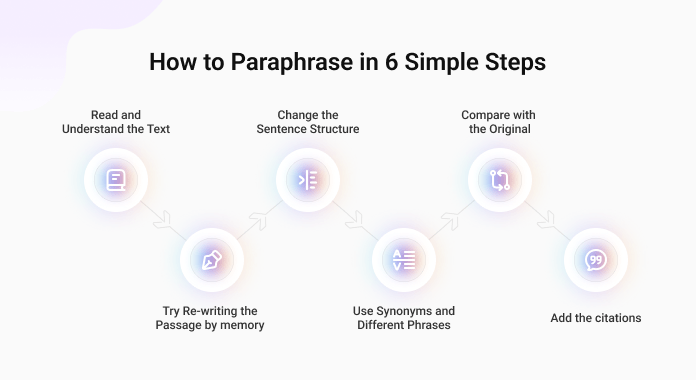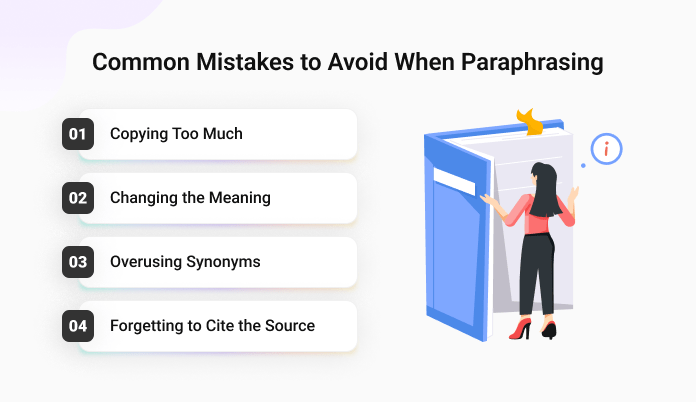
The process of rewording text while preserving its original meaning is known as paraphrasing. Paraphrasing indicates that you understand what the original text was all about. So you are not copying someone else, you are rethinking the text in your own way.
In this article, We will learn the steps involved in paraphrasing.
Follow these six simple steps to paraphrase effectively.

Firstly, go through the source articles in detail. rephrasing an article requires a solid understanding of the original information. Select the sections that you wish to paraphrase. Keep an eye out for arguments that expand the subject of the paper you're writing.
Ask yourself: What is the main idea? What is the author trying to say?
You have to think of fresh ways to convey the same information when you rephrase from memory. After that, you can review your notes and the original content to make sure everything you have written is correct and to add anything you have forgotten.
One of the easiest ways to paraphrase is by changing the sentence structure. There are two methods to change the sentence structure.
For example, the original text has the statement:
"Climate change is caused by human activities. These activities increase the concentration of greenhouse gasses."
A paraphrase could be:
"Human actions are the main cause of climate change, raising greenhouse gas levels."
Explanation:
In the paraphrase, the sentence structure has been changed by reordering the ideas. The phrase "concentration of greenhouse gasses" is changed to "raising greenhouse gas levels."
Another important step in paraphrasing is to use synonyms. Synonyms are words that have the same or similar meanings. However, be careful when choosing synonyms.
Remember, some words have multiple meanings, so make sure the synonym fits the context.
If the original text uses the word “important.” Instead, you could use “crucial” or “essential” in your paraphrase.
Example:
Original: "Water is vital for all living organisms."
Paraphrase: "Water is essential for the survival of living beings."
After you’ve written your paraphrase, compare it with the original text. Make sure you haven’t copied any phrases or sentences. The wording should be different, but the meaning should remain the same.
If your paraphrase is too similar, try changing more words or rearranging the sentence structure further. It’s important to ensure that your version is unique.
Don't forget to add the citation. Whether it's APA, MLA, or Chicago, make sure you're citing sources correctly. Most of the time, when quoting an article, you will include a paraphrase following the passage.
Familiarize yourself with listed below practices which can help you while paraphrasing.
Alternatively, you can utilize our AI Paraphraser to automatically restructure content for clarity. Then, you can learn to paraphrase effectively by mimicking the tool’s working.

As you can witness, the tool has resurfaced clarity in an otherwise wordy content. This method is a bit quicker to learn the basics of the paraphrasing process as the outputs are super fast and accurate. Plus, you can continuously experiment with the tool with different types of prompts, making learning engaging and intuitive.
Use the "Four R's of Paraphrasing" to accomplish your paraphrasing goal.
(A detailed video guide about Four R’s Paraphrasing)
Let’s look at some common mistakes and how to avoid them.

One common mistake is copying too much of the original text. Changing only a few words here and there is no proper paraphrasing. This can still be considered plagiarism.
To avoid this, focus on understanding the text. Then, write your version without looking at the original. This will force you to use your own words.
Sometimes you change the words but also change the meaning by mistake. This happens when you don’t fully understand the original text.
To avoid this, double-check your paraphrase against the original. Make sure the main ideas and details are accurate. If you’re unsure, reread the original text.
Using too many synonyms can make your paraphrase awkward or confusing. Some words don’t have exact synonyms. For example, words like “technology” or “democracy” are hard to replace with other words.
Instead of overusing synonyms, focus on changing the sentence structure. You can reword ideas in a way that sounds natural.
Even if you paraphrase, you must still give credit to the original source. Failing to cite the source is considered plagiarism. After your paraphrase, include a citation following the style your school requires (e.g., APA, MLA).
For example:
"According to Smith (2020), climate change is primarily caused by human activity."
An article on how to paraphrase effectively by the University of Technology Sydney
An article by PURDUE University on What is paraphrasing?
Paraphrasing | Definition & Examples by Study.com